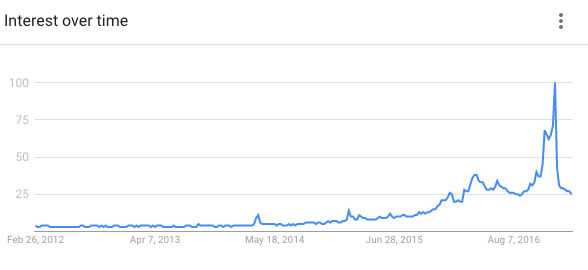
I’m a little late to the party to make New Year predictions for 2017, so let’s do something a bit different. Below are seven eCommerce predictions for the next 10 years: major trends I believe will reshape the way we sell online by 2027.
A Viable Alternative to Google and Facebook
We’ve entered a unique time where just a few major platforms have monopolized (or are close to monopolizing) the majority of traffic online. Someone in the eCommerceFuel Private Community went so far as to say the internet for store owners in 2017 consists mostly of Amazon, Facebook and Google. And I think they’re largely right.
Given these behemoths’ entrenched position and network effects, it’s hard to to knock them off their perch. Combine that with the demands on public companies to show ever-increasing profits and paid traffic costs for merchants, and it seems the giants will only continue their march upward.
So what happens a few years from now, when Google and Facebook have raised their rates to the point where it’s not feasible for most to profitably purchase traffic? When there’s no more surplus left to harvest?
I’m not sure what form it will take, but I predict a major traffic alternative for merchants will spring up in the next decade. One that will likely operate under a paradigm different from legacy social media or traditional search engines.
Perhaps it’s an open source search engine built on the promise of no ads with the goal of delivering truly unbiased results. Or maybe an independent review site that ranks stores and products based solely on reviews they generate, which are guaranteed unbiased.
But I do see the trend of ever-increasing ad costs and SERPs and Facebook feeds that are increasingly stuffed with paid content as unsustainable both for merchants and users.
Great Ads Will Become Table Stakes
Superbowl ads are among (if not the) most expensive advertising you can buy. There’s one commonality among almost all of them: They’re either humorous (or try to be!), or they aim to make a deep emotional connection.
They employ these techniques because they work. At a time where attention is getting exponentially harder to earn and more expensive to buy, fun creative and emotional advertising will become table stakes for getting noticed.
When Dollar Shave Club released its now infamous video in 2012 it made headlines due to its irreverent and funny approach. Fast forward to 2017 and I’m seeing videos like this everywhere.
Just in the last few months, examples from Purple Mattress and VidAngel come to mind (see below):
[embedded content]
[embedded content]
[embedded content]
[embedded content]
At the moment it’s mostly larger brands that are producing this kind of content. But by 2027 I think it will be a requirement for even smaller seven-figure store owners who don’t want to spend a fortune on paid traffic but want to see decent results.
Virtual Reality Is Not Dead
I’m not sure who issued the kill order, but virtual reality quickly went from being the next big thing in 2016 to an over-promised, dried-up technology that people now believe is dying.
Google Trends certainly doesn’t paint a rosy picture for the term “virtual reality”:
I believe VR will still play a major role in the future and will eventually be one of the primary ways people shop, enjoy sporting events and consume entertainment.
The problem? People expected the technology to mature practically overnight.
Consider the internet. It started to hit mainstream homes in the early ’90s, yet buying things online didn’t become widespread until nearly 15 years later.
The consumer version of the Oculus Rift was released less than a year ago. And because we haven’t seen massive adoption in 12 months, the powers that be have relegated VR to the scrap heap of tech.
Give it some time, people!
Any technology is expensive, buggy and over-hyped in the beginning. But I’d be shocked if at least 50% of computer users don’t own a VR headset by 2027.
Adoption of a Mobile Checkout Standard
Mobile use has exploded over the last five years, but there’s still a massive gap in conversion between phone and desktop. The biggest problem? Buying stuff on tiny screens is a huge pain.
Services like Apple Pay have promised to make that easier but still haven’t closed the gap. Part of the problem is that there’s no universal standard across devices and browsers.
Open platforms are difficult and sometimes go against the financial interests of big companies. However, I’m optimistic that the next five years will see the emergence of a universal mobile payment protocol that mobile vendors can use to facilitate easy payments via phone.
Think something similar to the “http” protocol for the web. You can get online with any number of browsers because they all speak the same language.
It’s such a huge, systemic problem encumbering online commerce I’ll be shocked if this isn’t fixed by 2027.
The Decade for Small, Unique Brands
In a recent Community discussion, our resident Amazon expert Lars Hundley summed up my thoughts perfectly on this issue when he said:
I feel like this decade is the era of small, unique brands.
Seth Godin has said, “You either need to be cheaper or better. If you try to be both — or are neither — you’ll fail.”
Amazon is cheaper. Wal-Mart is cheaper. Good luck trying to beat them without spending billions beefing up your own supply chain.
Stores like Beardbrand, Asildastore, Whipping Post, Linjer, FCTRY, Island Apothecary and Gransfors Bruk are better. They have unique products, yes. But more importantly, they have soul and a story to tell.
Amazon and brands like these will be the two types of eCommerce that thrive during the next decade.
Amazon Will Become a Less Appealing Channel
In the 2017 State of the Merchant report, I compared profit margins between merchants selling primarily on Amazon and those who focused on their own sites.
Profit margins were nearly identical: 17.6% for storefront sellers vs. 17.9% for Amazon heavy sellers.
With nearly identical margins, what’s the biggest appeal of Amazon? Speed and scale. You can grow on Amazon amazingly fast and scale without needing to hire a team or build out infrastructure.
But that comes at a cost. You have to get comfortable with two scary things:
First, it’s widely known that Amazon uses you for market research and often introduces its own products to compete with successful sellers. This is just one of the many dangers of selling on Amazon. It may not make sense for Amazon to make its own version of your relatively niche product now, but as time goes on and some of its lower-hanging fruit gets in-sourced, it may become more appealing.
Second, you’re trading speed and scalability for ownership. If Amazon decides to jack up its fulfillment or commission rates by 35%, there’s not much you can do about it. This is doubly true in 10 years, when Amazon’s marketshare will be exponentially larger.
As it grows, I believe Amazon will increasingly compete directly with sellers and likely leverage its monopoly to raise rates. As the biggest game in town, it will still be a channel you can’t overlook, but I predict a strong dampening of the euphoria we’ve seen around Amazon in recent years. I also think we’ll see the discussion taking on more confrontational undertones as sellers increasingly compete with Amazon head-to-head.
If you do sell on Amazon make sure you’re aware of the top mistakes Amazon sellers make and how to avoid them.
Stores Will Grow Dramatically Leaner
I woke up earlier this month to a front page in my print copy of the Wall Street Journal titled “The End of Employees.” It outlined how companies are increasingly utilizing contractors for everything apart from their core competencies.
And it’s not just Fortune 500 companies. I’m increasingly seeing this with store owners.
In my Keynote talk at eCommerceFuel Live last year I studied a group of store owners I dubbed “cash cows.” These were stores that managed to generate 5x more profits per employee ($125K per employee vs. the average $25K per employee).
Among the commonalities they shared were a focus on manufacturing, smaller catalog sizes and an increased likelihood to outsource using contractors and third-party logistics (3PLs).
Even over the last year I’ve noticed a number of SaaS apps spring up that are now addressing the needs I previously had a VA do.
Between technology, 3PLs and access to a deep pool of global contractors, I think we’ll see the average number of employees and required overhead for store owners dramatically decrease over the next decade.
This is great news if you’re a store owner, as it means a more efficient, profitable operation. But what do you do if you’re trying to get a job in eCommerce and aren’t quite ready to start your own gig?
Two things spring to mind. First, understand technology really well. If you can leverage the tech tools out there to help owners run and automate their businesses, you will, counterintuitively, make yourself invaluable.
Second, make sure you bring expertise to the table from day one. Whether it’s fair or not, I regularly speak with owners who are looking for team members who can hit the ground running and, perhaps most importantly, are able to teach themselves.
“I don’t like managing people,” a well-known tech entrepreneur told me a few weeks ago. “I like people who can see the problem, jump in and start quickly making progress.”
Again, it may not be fair or nice to hear. But I think this is the reality that many face in the hiring world today.
Where Did I Get It Wrong?
One of the great things about making predictions a decade out is that it’ll take a while to be proven wrong! Don’t let me escape unscathed. In the comments below, challenge me on any predictions you think are off-base or flat-out wrong.
And if you enjoyed this article, sign up here to be notified when I publish new content, usually once or twice a month. You’ll also get my subscriber-only newsletter where I talk about business, travel, great books and more each month.
Photo credit by Alex.



![15+ Top Black Friday & Cyber Monday Deals for Developers and Designers [2023]](https://wiredgorilla.com/wp-content/uploads/2023/11/15-top-black-friday-cyber-monday-deals-for-developers-and-designers-2023.jpg 1460w, https://wiredgorilla.com/wp-content/uploads/2023/11/15-top-black-friday-cyber-monday-deals-for-developers-and-designers-2023-300x168.jpg 300w, https://wiredgorilla.com/wp-content/uploads/2023/11/15-top-black-friday-cyber-monday-deals-for-developers-and-designers-2023-1024x575.jpg 1024w, https://wiredgorilla.com/wp-content/uploads/2023/11/15-top-black-friday-cyber-monday-deals-for-developers-and-designers-2023-768x431.jpg 768w)